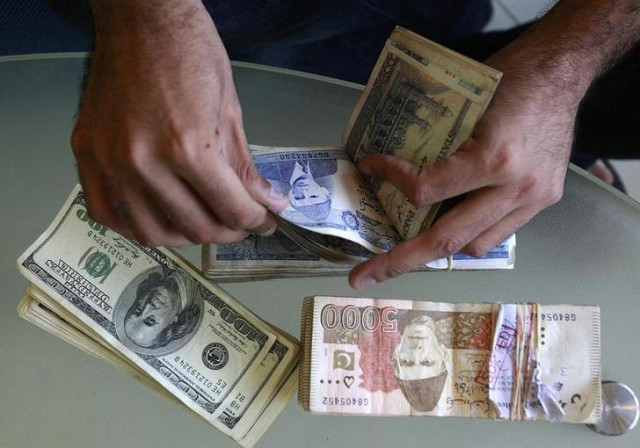
The fall comes days after the government concluded post-programme monitoring talks with the International Monetary Fund (IMF), a repeat of what happened in December when the rupee weakened close to 5% right after discussions with the global lender concluded.
On Tuesday, the currency closed at Rs115 against the greenback in the inter-bank market over the previous day’s closing of Rs110.57. The government has devalued the currency for a second time in three months. During intra-day trading, the exchange rate went as high as Rs116.50 but eventually settled at Rs115.
After the rupee devaluation, the market is now anticipating a hike in the key discount rate by at least 25 basis points to 6.25% in the next announcement by the Monetary Policy Committee of the SBP.
Rupee loses almost 5%, KSE-100 gains almost 1.8% in intra-day trading
Cumulatively, the rupee has now lost its value by Rs10 or 9.52% since December 2017.
The fresh devaluation came four days after the IMF said in its post-programme monitoring report that “maintaining a largely stable nominal exchange rate amid mounting external pressures has led to losses of international reserves”.
It added that the current account deficit has been quickly widening, reflecting strong domestic demand amid an overvalued exchange rate, fiscal slippages and an accommodative monetary policy stance.
As of February 14, Pakistan’s Net International Reserves stood at minus $724 million – down from $7.5 billion in September 2016 when the three-year IMF programme ended, according to the report that the IMF released last Thursday.
“It is market-driven, based on some payment pressures,” said chief spokesman of the State Bank of Pakistan (SBP) Abid Qamar while responding to a question on the rupee’s slide against the US dollar.
Last Thursday, Ismail called the exchange rate devaluation the best tools in the hands of the government to tackle the current account deficit. He said that SBP’s monetary tightening policy could also help address these problems.
Pakistan's 'net reserves stand at minus $724m'
The sources in the finance ministry told The Express Tribune that the decision to further devalue the rupee was taken by the ministry on SBP’s advice. They said this was not the last intervention in the market as there were chances of at least one more such intervention before end June.
With the fresh fall, the rupee has now lost a cumulative 9.5% or Rs10 in the inter-bank market since December.
However, 9.5% devaluation of the currency would increase the country’s external debt burden by an additional Rs875 billion or $7.6 billion – without borrowing a cent. In September 2017, the country’s external debt and liabilities amounted to $85 billion. At the then exchange rate of Rs105 to a dollar, Pakistan would have required Rs8.9 trillion to service this debt. At the current exchange rate of Rs115, Pakistan will need Rs9.8 trillion to service this debt.
As of end December, the external debt and liabilities have already mounted to $89 billion and the chances are this figure fast head towards $100 billion by June, according to the sources.
However, the Federal Board of Revenue will be the beneficiary of the rupee devaluation as its collects almost half of its total revenues at the import stage which includes custom duties, regulatory duties, sales tax and withholding tax.
SBP proposes changes in rules for foreign currency account holders
The continuous rupee devaluation starkly reminds of Pakistan’s weakening economic position, widening current account and trade deficits as well as dwindling foreign exchange reserves.
During the first eight months (July-February) of the ongoing fiscal year, Pakistan’s current account deficit widened to $10.82 billion – higher than the $8.9 billion annual estimates of former finance minister Ishaq Dar. This is despite the fact that Pakistan imposed heavy regulatory duties on imported goods and erected non-tariff barriers to discourage imports.
The IMF has estimated Pakistan’s current account deficit at $15.7 billion by June this year.
It said that Pakistan’s decision to control the import bill through administrative measures like imposing regulatory duties and maintaining cash margin requirements had limited effects as the reserves continued to decline.
The official gross foreign currency reserves stood at $12.1 billion as of end of last week which are rapidly going down.
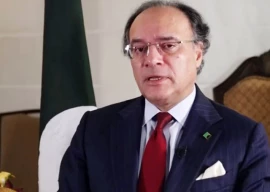

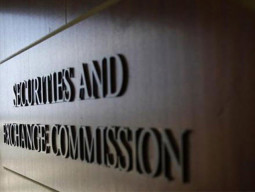

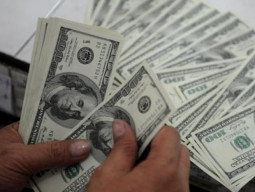

1726054615-0/OpenAI-(2)1726054615-0-270x192.webp)




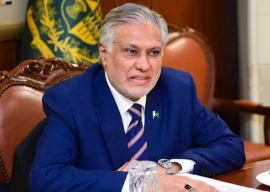






COMMENTS
Comments are moderated and generally will be posted if they are on-topic and not abusive.
For more information, please see our Comments FAQ